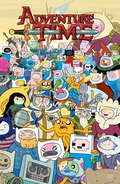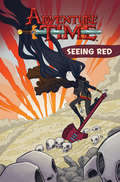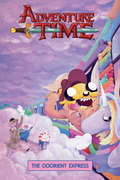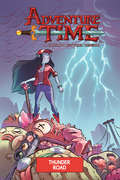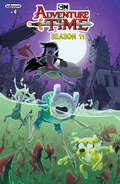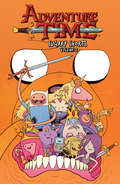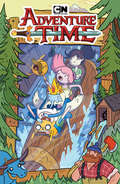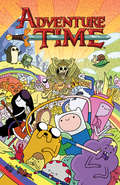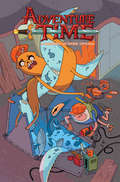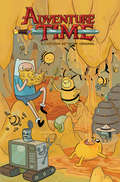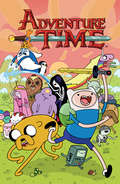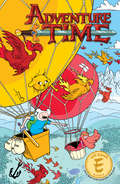- Table View
- List View
Adventure Time Original Graphic Novel: President Bubblegum (Planet of the Apes #8)
by Pendleton Ward Josh Trujillo Philip Murphy<p>The King of Ooo approaches the Candy Castle and proclaims that he has discovered the long-lost ConstitOootion. When Candy Law Professor verifies the authenticity of the document, which states in one week there will be an election for Ooo's first President, Princess Bubblegum will have to race against her enemies...and frenemies, to ensure her spot on the throne! <p>This is a fixed-format ebook, which preserves the design and layout of the original print book.</p>
Adventure Time Original Graphic Novel: Princess and Princess (Planet of the Apes #11)
by Pendleton Ward<p>When Finn is asked to kingdom-sit for Rock Princess, he’s excited to take a break from his usual responsibilities. That is, until the underground kingdom turns to him with pressing matters in need of deliberation. Now charged with “princess” duties, Finn is overwhelmed by his new job. Especially if it means war against...Princess Bubblegum! <p>This is a fixed-format ebook, which preserves the design and layout of the original print book.</p> <P><P> <i>Advisory: Bookshare has learned that this book offers only partial accessibility. We have kept it in the collection because it is useful for some of our members. Benetech is actively working on projects to improve accessibility issues such as these.</i>
Adventure Time Original Graphic Novel: Seeing Red (Planet of the Apes #3)
by Pendleton Ward Kate Leth Zachary Sterling<p>An original graphic novel starring Marceline the Vampire Queen! <p>This is a fixed-format ebook, which preserves the design and layout of the original print book.</p> <P><P> <i>Advisory: Bookshare has learned that this book offers only partial accessibility. We have kept it in the collection because it is useful for some of our members. Benetech is actively working on projects to improve accessibility issues such as these.</i>
Adventure Time Original Graphic Novel: The Ooorient Express (Planet of the Apes #10)
by Pendleton Ward Zachary Sterling Jeremy Sorese<p>Candy, suspicious conductors, and weird science make up this all-new Adventure Time original graphic novel written by Jeremy Sorese (Curveball, Steven Universe) and illustrated by Adventure Time veteran Zachary Sterling. Don't miss out on this action-packed journey based on the award-winning show on Cartoon Network! Lady Rainicorn has come down with a case of taffy fever and there is nothing Jake can do to help her. After many failed attempts with Princess Bubblegum, Finn and Jake learn of a special cure that can help Lady Rainicorn get back to normal. The catch? They will have to travel on the Ooorient Express on an infamous train ride that no one returns from... <p>This is a fixed-format ebook, which preserves the design and layout of the original print book.</p> <P><P> <i>Advisory: Bookshare has learned that this book offers only partial accessibility. We have kept it in the collection because it is useful for some of our members. Benetech is actively working on projects to improve accessibility issues such as these.</i>
Adventure Time Original Graphic Novel: Thunder Road (Planet of the Apes #12)
by Pendleton Ward Zachary Sterling Jeremy Sorese<p>Marceline starts feeling restless and comes across a motorcycle gang of storm clouds. Marceline sets off on the open road with her new friends but things take a turn when she realizes that the storm clouds might be taking things a bit too far when it comes to their pranks. Luckily, the answer comes from an unexpected source who just happened to be trailing the clouds… for research, of course. <p>This is a fixed-format ebook, which preserves the design and layout of the original print book.</p> <P><P> <i>Advisory: Bookshare has learned that this book offers only partial accessibility. We have kept it in the collection because it is useful for some of our members. Benetech is actively working on projects to improve accessibility issues such as these.</i>
Adventure Time Season 11 #4 (Adventure Time Season 11 #4)
by Ted Anderson Marina Julia Meg Casey Sonny LiewWhen Marceline loses her memories, everyone suspects foul play! Finn, Jake, Princess Bubblegum, and Simon must band together to save their friend!
Adventure Time Season 11 #5 (Adventure Time Season 11 #5)
by Ted Anderson Marina Julia Meg Casey Sonny LiewWhen Finn and Jake are finally ready to find a new home after their treehouse was destroyed during Golb’s attack, an unlikely group makes shore on Ooo, leading Finn to confront the question of where he truly belongs.
Adventure Time Season 11 #6 (Adventure Time Season 11 #6)
by Ted Anderson Sonny LiewAs Finn and Jake deal with the unlikely group that comes to Ooo’s shores, Finn gets put in a delicate position when Princess Bubblegum gets involved.
Adventure Time Season 11 (Adventure Time Season 11 #1)
by Ted Anderson Marina Julia Meg Casey Sonny Liew<p>Cartoon Network’s award-winning animated series Adventure Time will conclude this fall with Season 10—but this October, KaBOOM! proudly continues telling the stories of Finn and Jake in a new Season 11 comic series! In the aftermath of The Great Gum War, Finn, Jake and the entire land of Ooo begin to pick up the pieces with some new and unexpected friends. Written by Eisner Award-winning writer Sonny Liew (The Art of Charlie Hock Chye) and illustrated by Marina Julia (Lumberjanes: Faire and Square), this is the only place fans can get new stories in the land of Ooo! <p>This is a fixed-format ebook, which preserves the design and layout of the original print book.</p>
Adventure Time Season 11 (Adventure Time Season 11 #3)
by Ted Anderson Marina Julia Meg Casey Sonny LiewFinn and Jake learn that there is a reason that the three henchmen are so determined to find “precious” objects for Marceline, and it’s not anything good. Hunson Abadeer makes a show!
Adventure Time Sugary Shorts (Peanuts #2)
by Pendleton Ward<p>Collecting stories by amazing creators from around the world, Sugary Shorts Volume Two stars all your favorite characters from Marceline the Vampire Queen to Cinnamon Bun. This collection contains so much sugary goodness it's almost too sweet to handle. Featuring the work of Dustin Nguyen, Noelle Stevenson, Roger Langridge, Frazer Irving, and more! <p>This is a fixed-format ebook, which preserves the design and layout of the original print book.</p>
Adventure Time Sugary Shorts (Planet of the Apes #4)
by Pendleton Ward<p>Collecting stories by comic creators from around the world, Sugary Shorts stars all your favorite Adventure Time characters, from Fionna the Human to Billy the Hero. Includes fantastical tales from Kat Leyh (Lumberjanes), Jake Wyatt (Ms. Marvel), Michael Dialynas (The Woods), Kel McDonald (Misfits of Avalon), and more. <p>This is a fixed-format ebook, which preserves the design and layout of the original print book.</p>
Adventure Time Sugary Shorts: Sugary Shorts (Peanuts #1)
by Pendleton Ward<p>Comic creators from around the world unite to celebrate all things ADVENTURE TIME in this collection of incredibly original mini-adventures. Starring all of your favorite characters from Finn and Jake to Hot Dog Princess and Peppermint Butler, SUGARY SHORTS Volume One is a syrupy salute to the Land of Ooo that is sure to satisfy your sweet tooth. <p>This is a fixed-format ebook, which preserves the design and layout of the original print book.</p>
Adventure Time Vol. 16 (Adventure Time #16)
by Kevin Cannon Joey McCormick Maarta LaihoIt’s double trouble throughout all of Ooo! When Finn and Jake discover an Adventure-themed Theme Park, our favorite adventurers get more than they bargained for when visiting the Wish Witch. Now stuck with an ever-growing amount of doubles, Finn and Jake set off to reverse the spell before the doubles overrun the Candy Kingdom. Collects issues #70-73
Adventure Time Vol. 17 (Adventure Time #17)
by Ryan North Mariko Tamaki Christopher Hastings Conor McCreery Pendleton Ward Kiernan Sjursen-LienAfter six years and 75 issues, Finn, Jake, and your favorite characters from Cartoon Network’s Adventure Time star in their final collection from the ongoing series. Together, they’ll face off against Magic Man stealing the colors from Ooo and take on one of their most challenging quests of all: a royal wedding... And there’s even a special adventure starring Fionna & Cake as they retrieve the punch for Prince Gumball’s semi-annual Punch Parade! Featuring a tour-de-force of creators from across Adventure Time history—including writers Ryan North (The Unbeatable Squirrel Girl), Mariko Tamaki (This One Summer), and Christopher Hastings (The Unbelievable Gwenpool), along with artists Shelli Paroline & Braden Lamb (Making Scents), Ian McGinty (Invader Zim), and Zachary Sterling (Bee & Puppycat)—this final journey through Ooo is a must-have for every fan.
Adventure Time Volume 1 (Planet of the Apes #1 - 4)
by Pendleton Ward<p>The totally algebraic adventures of Finn and Jake have come to the comic book page! The Lich, a super-lame, SUPER-SCARY skeleton dude, has returned to the the Land of Ooo, and he's bent on total destruction! Luckily, Finn and Jake are on the case...but can they succeed against their most destructive foe yet? Featuring fan-favorite characters Marceline the Vampire Queen, Princess Bubblegum, Lumpy Space Princess and the Ice King! Collecting issues 1-4 of the smash hit ADVENTURE TIME comics series by Ryan North, Shelli Paroline and Braden Lamb! <p>This is a fixed-format ebook, which preserves the design and layout of the original print book.</p>
Adventure Time Volume 10 (Planet of the Apes #45 - 49)
by Pendleton Ward<p>Josh leaves Finn and Jake a message to navigate a secret cave to find an artifact but hey, one of the walls caved in, so they don't have to listen to all of it! Then again, there might have been some important info on that recording. Join Finn and Jake as they take on...a new sister?! It's memories versus curses as our two best pals do what they do best: break statues and cause a ruckus. Collects issues 45-49. <p>This is a fixed-format ebook, which preserves the design and layout of the original print book.</p>
Adventure Time Volume 11 (Planet of the Apes #50 - 53)
by Pendleton Ward<p>Jake just wants to have a nice relaxing weekend without any adventures. Not too much to ask for, right? Too bad the Governor of Ghost-A- Rica has plans of his own and that means releasing his ghost minions to steal the youth of all the citizens in Ooo. It's a battle for youth, literally! Collects issues 50-53. <p>This is a fixed-format ebook, which preserves the design and layout of the original print book.</p>
Adventure Time Volume 12 (Planet of the Apes #54 - 57)
by Pendleton Ward<p>Finn and Jake wake up in a bizarre world inside of BMO, and it looks like BMO is determined to give them the best game of their lives! Collects issues 54-57. <p>This is a fixed-format ebook, which preserves the design and layout of the original print book.</p>
Adventure Time Volume 13 (Planet of the Apes #58 - 61)
by Pendleton Ward<p>When old friends and enemies sudden make a resurgence in Ooo, Finn and Jake know that something is about to go down... Between building their own dungeon and saving the world, the heroes might be stretched too thin. If they can't save the day, then who can? Collects issues 58-61. <p>This is a fixed-format ebook, which preserves the design and layout of the original print book.</p>
Adventure Time Volume 14 (Planet of the Apes #62 - 65)
by Mariko Tamaki Maarta Laiho Ian McGinty<p>The competition for Best Princess Ever is in full swing! As Lumpy Space Princess, Fire Princess, Muscle Princess, and more compete for the title, it’s discovered that someone is sabotaging the games. With Finn and Jake on the case, Princess Bubblegum will have to keep the show going until they can track down the true culprit and save the day. Written by The New York Times bestselling author Mariko Tamaki (This One Summer) and illustrated by Ian McGinty. Collects issues 62-65. <p>This is a fixed-format ebook, which preserves the design and layout of the original print book.</p>
Adventure Time Volume 15 (Planet of the Apes #66 - 69)
by Delilah S. Dawson Maarta Laiho Ian McGinty Pendleton Ward<p>Join Princess Bubblegum, Marceline, and LSP as they take on Finn, Jake, and BMO in a hot air balloon race around the land as they try to see who can gather up the three pieces of gold that will get them their ultimate prize. Collects issues 66-69. <p>This is a fixed-format ebook, which preserves the design and layout of the original print book.</p>
Adventure Time Volume 2: Sugary Shorts Mathematical Edition (Planet of the Apes #5 - 9)
by Pendleton Ward<p>Join Finn the Human, Jake the Dog, and Princess Bubblegum for all-new adventures in The Land of Ooo. Experience the algebraic adventures with your favorite characters like Marceline the Vampire Queen, Lumpy Space Princess, Ice King, Peppermint Butler, and so many more. Not only does this graphic novel collect the out-of-control, adventure-packed third story arc, it also includes the unforgettable "Choose Your Own Adventure" story. Collecting issues 5-9 of the smash hit ADVENTURE TIME comics series by Ryan North, Shelli Paroline and Braden Lamb! <p>This is a fixed-format ebook, which preserves the design and layout of the original print book.</p> <P><P> <i>Advisory: Bookshare has learned that this book offers only partial accessibility. We have kept it in the collection because it is useful for some of our members. Benetech is actively working on projects to improve accessibility issues such as these.</i>
Adventure Time Volume 3 (Planet of the Apes #10 - 14)
by Pendleton Ward<p>The all-ages hit of the year is back with a new volume collecting even more algebraic adventures! What happens when Jake the dog and Finn the human get a hold of Princess Bubblegum's time machine and travel into the future? Can you say ROBOT FINN & JAKE? Find out more in this exciting volume! Collecting issues 10-14 of the smash hit ADVENTURE TIME comics series by Ryan North, Shelli Paroline and Braden Lamb! <p>This is a fixed-format ebook, which preserves the design and layout of the original print book.</p>
Adventure Time Volume 4 (Planet of the Apes #15 - 19)
by Pendleton Ward<p>Join best pals Jake the Dog, Finn the Human, and... the ICE KING?! It's a DUNGEON BROVENTURE as this crazy trio jumps into a game of danger of feelings! Will the treasure at the end be worth all the crazy emotions, or have Finn and Jake finally found a quest they won't be able to finish? Collecting issues 15-19 of the smash hit ADVENTURE TIME comics series by Ryan North, Shelli Paroline and Braden Lamb! <p>This is a fixed-format ebook, which preserves the design and layout of the original print book.</p>

